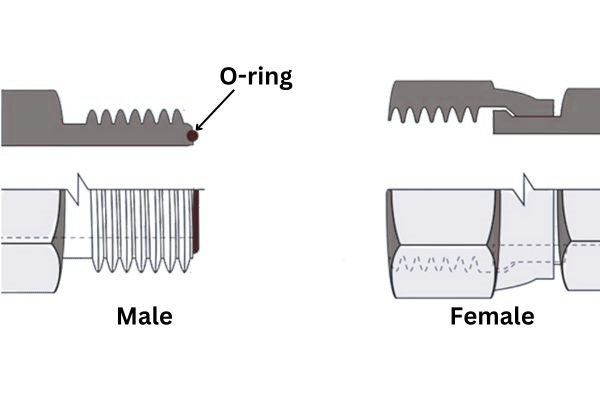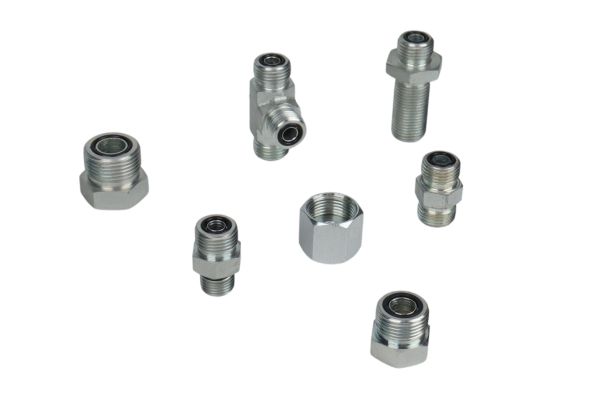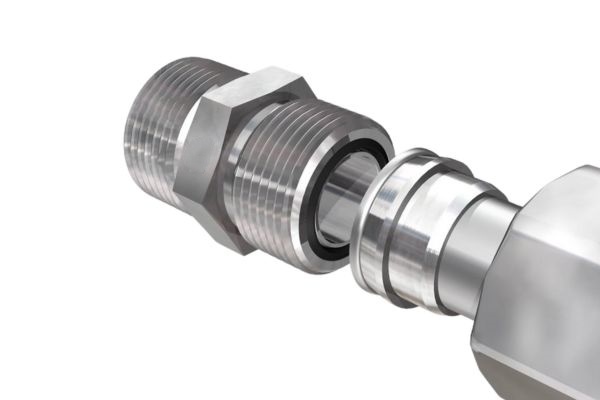Hydraulic fittings are essential components in hydraulic systems, connecting various parts to ensure the seamless flow of hydraulic fluid. Among the numerous types of hydraulic fittings, O-Ring Face Seal fittings stand out due to their unique design and exceptional performance. These fittings utilize an O-ring mechanism to create a secure, leak-proof seal, making them indispensable in high-pressure applications. This article aims to provide a comprehensive overview of ORFS fittings, their functionality, benefits, and applications, equipping readers with the knowledge needed to make informed decisions in their hydraulic projects.
ORFS (O-Ring Face Seal) fittings are specialized hydraulic connectors designed to provide a secure and leak-proof seal in high-pressure applications. The defining feature of these fittings is the incorporation of an O-ring, which is positioned in the face of the fitting. When connected, the O-ring is compressed between the fitting and its counterpart, creating a robust seal that prevents hydraulic fluid leaks.
The development of ORFS fittings can be traced back to the mid-20th century when the demand for more reliable hydraulic systems in industrial and military applications grew significantly. Engineers and manufacturers sought to design fittings that could withstand higher pressures and more extreme conditions than traditional fittings. This need led to the creation of the ORFS design, which has since become a standard in various high-performance hydraulic systems due to its superior sealing capabilities.

O-ring Face Seal Design
The O-ring face seal design is the hallmark of ORFS fittings. This design ensures that when the fitting is tightened, the O-ring is compressed evenly, creating a high-integrity seal. This method significantly reduces the risk of leaks compared to threaded or metal-to-metal seal fittings. The O-ring material is typically chosen based on the fluid and temperature conditions it will encounter, ensuring compatibility and longevity.
Materials Used
ORFS fittings are commonly manufactured from robust materials to handle the demands of high-pressure systems. The most frequently used materials include:
Sizes and Dimensions
ORFS fittings are available in a wide range of sizes to accommodate different hydraulic systems and applications. Standard sizes typically range from 1/8 inch to 2 inches in diameter. The dimensions of ORFS fittings are standardized to ensure compatibility across various manufacturers and systems. This standardization facilitates easy replacement and interchangeability, contributing to the overall efficiency and reliability of hydraulic systems.
Explanation of the Sealing Mechanism
O-Ring Face Seal fittings are engineered to provide a reliable, leak-free connection in hydraulic systems. The primary sealing mechanism involves an O-ring that sits in a groove on the face of the fitting. When the fitting is tightened, the O-ring is compressed against the mating surface, creating a tight seal. This design ensures that the seal is maintained under high pressure and vibration, which are common in hydraulic systems. The O-ring’s flexibility allows it to adapt to minor surface imperfections, ensuring a consistent seal even if the mating surfaces are not perfectly smooth.
The Role of the O-ring in Preventing Leaks
The O-ring is the critical component in the ORFS fitting’s ability to prevent leaks. Made from materials like nitrile rubber (NBR), fluorocarbon (Viton), or ethylene propylene diene monomer (EPDM), the O-ring is chosen based on the specific requirements of the hydraulic fluid and operating temperature. When the ORFS fitting is assembled, the O-ring is compressed, filling the gap between the fitting faces and creating a barrier that prevents hydraulic fluid from escaping. This compression also absorbs shock and vibration, which further reduces the likelihood of leaks over time. The O-ring’s resilience and ability to maintain its shape under pressure make it an effective seal in demanding environments.
Due to their superior sealing capabilities, ORFS fittings are widely used in industries where high pressure and reliability are critical. Some typical applications and industries include:
Agriculture
Agricultural machinery, such as tractors and harvesters, rely on hydraulic systems for operation. ORFS fittings provide the durability and leak-free performance needed to withstand the demanding conditions of agricultural work.
Construction
Construction equipment, including excavators, loaders, and cranes, use ORFS fittings in their hydraulic systems to ensure reliable performance under heavy loads and constant movement.
Industrial Manufacturing
In manufacturing plants, hydraulic systems power machinery and robotics. ORFS fittings help maintain consistent pressure and prevent leaks, ensuring smooth operation and reducing downtime.
Marine
Marine applications, such as hydraulic steering and winch systems, benefit from ORFS fittings’ ability to resist corrosion and maintain a leak-free seal in harsh, saltwater environments.
Automotive
High-performance and heavy-duty vehicles, including trucks and construction vehicles, use ORFS fittings in their hydraulic systems for braking, steering, and suspension components, ensuring reliable operation under demanding conditions.
ORFS fittings are often compared with other types of hydraulic fittings, such as JIC (Joint Industry Council), NPT (National Pipe Thread), and BSP (British Standard Pipe). Each of these fittings has unique characteristics and applications, as well as distinct sealing mechanisms.

Characteristics: JIC fittings, developed by the Joint Industry Council, are known for their 37-degree flare seating surface. They are widely used in various hydraulic applications due to their robustness and versatility. JIC fittings are typically made from materials like stainless steel, brass, and carbon steel, providing durability and resistance to corrosion.
Sealing Mechanism: The sealing in JIC fittings is achieved through a metal-to-metal seal. The tubing is flared at a 37-degree angle and mates with the nose of the fitting, creating a seal when the connection is tightened. This metal-to-metal contact provides a strong and reliable seal under moderate pressure and vibration. However, the seal’s effectiveness depends on the quality of the flare and the surface finish of the mating components. In high-pressure or highly dynamic environments, JIC fittings may not provide as reliable a seal as ORFS fittings due to potential imperfections in the metal surfaces.
Characteristics: NPT fittings, or National Pipe Thread fittings, are widely used in North America for various plumbing and hydraulic applications. NPT fittings have a tapered thread design, which increases the interference fit as the connection is tightened. These fittings are commonly made from materials such as stainless steel, brass, and carbon steel.
Sealing Mechanism: The primary sealing mechanism in NPT fittings is the interference created by the tapered threads. As the fitting is tightened, the threads compress against each other, creating a seal. However, due to the nature of thread engagement, NPT fittings often require additional sealing aids like thread sealant or Teflon tape to ensure a leak-free connection. This reliance on supplementary sealing methods can be a disadvantage in high-pressure applications, where the risk of leaks and thread damage is higher compared to the O-ring seal in ORFS fittings. Furthermore, NPT fittings can be more challenging to install correctly, as over-tightening can damage the threads and under-tightening can result in leaks.
Characteristics: BSP (British Standard Pipe) fittings are commonly used in Europe and other parts of the world. BSP fittings come in two main types: BSPP (British Standard Pipe Parallel) and BSPT (British Standard Pipe Tapered). BSPP fittings have parallel threads, while BSPT fittings have tapered threads. These fittings are typically manufactured from stainless steel, brass, and carbon steel, offering good resistance to corrosion and durability.
Sealing Mechanism:
Definition: ORB (O-Ring Boss) fittings, on the other hand, seal via an O-ring seated in a chamfered groove at the base of the male thread. The O-ring compresses against a machined flat surface inside the female port, creating a seal at the boss (bottom of the thread).
Thread Engagement: ORFS typically uses straight threads (SAE J1453) with a face seal, while ORB also uses straight threads (SAE J514) but relies on sealing at the thread base rather than the face.
Pressure & Vibration Resistance: ORB is effective for many applications, but under extreme vibration or repeated torque cycles, seal failure or loosening may occur more frequently than with ORFS.
Standard Overview:Metric DIN fittings are standardized under DIN 2353 and ISO 8434-1. They use a 24° cone inside the female fitting and a corresponding cutting ring or flare to seal with the male fitting.
Metric DIN fittings come in two pressure categories:
Light Series (L): for medium-pressure applications.
Heavy Series (S): for high-pressure systems.
Sealing Mechanism: DIN fittings seal via metal-to-metal contact between the 24° cone and the ferrule/cutting ring.
Pressure Ratings:
ORFS typically handles up to 6,000 psi (414 bar), depending on size and material.
DIN Heavy Series can also reach similar pressures but is less tolerant to vibration due to the rigid metal-to-metal interface.
ORFS hydraulic fittings come in various configurations to meet the diverse needs of hydraulic systems. These fittings are designed to provide leak-free connections in high-pressure applications, and each type serves specific purposes. The main types of ORFS fittings include straight fittings, elbow fittings, tee fittings, and adapter fittings. Each type has unique applications, ensuring optimal performance and flexibility in different hydraulic systems.

Characteristics and Uses:
Straight fittings are the simplest type of ORFS fittings, featuring a straight design that connects two hydraulic components in a linear fashion. These fittings are commonly used in situations where there is a need to join hoses or pipes without changing the direction of the flow. They are available in various sizes to accommodate different hydraulic system requirements.
Specific Applications:
Connecting hydraulic hoses to pumps or valves.
Extending hydraulic lines without altering the flow direction.
Used in systems where space constraints require a direct connection between components.
Characteristics and Uses:
Elbow fittings are designed with a 45-degree or 90-degree bend, allowing the hydraulic flow to change direction. These fittings are crucial in systems where space constraints or design requirements necessitate a change in the flow direction. Elbow fittings help to maintain system efficiency and prevent hose kinking, which can lead to pressure drops and potential leaks.
Specific Applications:
Routing hydraulic lines around obstacles or within confined spaces.
Connecting hoses or pipes in machinery with complex geometries.
Used in hydraulic systems where directional changes are needed to optimize flow paths.
Characteristics and Uses:
Tee fittings feature a T-shaped design, allowing a single hydraulic flow to split into two separate lines or combine two flows into one. These fittings are essential for creating branches in hydraulic systems, enabling the distribution of hydraulic fluid to multiple components.
Specific Applications:
Dividing hydraulic fluid flow to power multiple actuators or cylinders.
Combining flows from different lines into a single return line.
Used in complex hydraulic systems where multiple functions are operated from a single fluid source.
Characteristics and Uses:
Cross fittings, also known as four-way fittings, feature a cross-shaped design that allows fluid to flow through four different points. This type of fitting is used when there is a need to split or combine hydraulic lines in four different directions. Cross fittings are essential in complex hydraulic circuits where multiple branches are necessary.
Specific Applications:
Distributing hydraulic fluid to multiple cylinders or actuators in machinery.
Creating intricate hydraulic circuits in industrial automation systems.
Used in hydraulic systems where multiple functions need to be powered from a single source, such as in agricultural equipment with multiple hydraulic attachments.
Characteristics and Uses:
Crimped fittings are attached to hydraulic hoses using a crimping process, which permanently secures the fitting to the hose. These fittings provide a reliable and secure connection that is resistant to high pressure and vibration. Crimped fittings are widely used in applications where durability and safety are paramount.
Specific Applications:
High-pressure hydraulic systems in construction equipment, such as excavators and loaders.
Hydraulic systems in industrial machinery where frequent hose replacements are impractical.
Used in mobile equipment, such as trucks and heavy-duty vehicles, where reliable connections are essential for safety and performance.
Characteristics and Uses:
Reusable fittings, also known as field attachable or screw-on fittings, can be attached to hydraulic hoses without the need for crimping equipment. These fittings can be easily removed and reattached, making them ideal for maintenance and repair applications. Reusable fittings provide flexibility and convenience, especially in field service scenarios.
Specific Applications:
Emergency repairs in hydraulic systems where immediate hose replacements are necessary.
Maintenance operations in remote locations where crimping equipment is unavailable.
Used in hydraulic systems that require frequent disassembly and reassembly, such as test rigs and prototypes.
Selecting the right ORFS (O-Ring Face Seal) fitting for your hydraulic system is crucial to ensure optimal performance, reliability, and safety. Several factors must be considered to make an informed decision.
Importance: Hydraulic systems operate under various pressure levels. Selecting a fitting that can withstand the system’s maximum pressure is essential to prevent leaks and ensure safety.
Considerations: Check the pressure rating of the ORFS fitting, typically provided by the manufacturer. Ensure it matches or exceeds the operating pressure of your hydraulic system.
Importance: Hydraulic systems may be subjected to a wide range of temperatures, from extremely cold to very hot conditions. The fitting must be capable of performing reliably within this temperature range.
Considerations: Examine the temperature range specified for the ORFS fitting and ensure it aligns with the expected operating temperatures of your system. The O-ring material should also be suitable for these temperatures to maintain its sealing properties.
Importance: The type of hydraulic fluid used in the system can affect the fitting’s performance and durability. Different fluids may have varying chemical properties that can interact with the fitting materials.
Considerations: Identify the type of hydraulic fluid (e.g., petroleum-based, synthetic, water-glycol) and ensure the ORFS fitting’s materials, including the O-ring, are compatible. Manufacturers often provide compatibility charts to help with this selection.
Importance: Ensuring that the new ORFS fitting is compatible with your existing hydraulic system components is crucial for seamless integration and performance.
Considerations:
Thread Type and Size: Verify that the fitting’s threads match those of the existing components. Mismatched threads can cause leaks and damage to the system.
Material Compatibility: Ensure that the materials of the fitting are compatible with the existing system components to prevent galvanic corrosion or other adverse interactions.
Dimensional Fit: Check that the dimensions of the fitting align with the space and layout of your system to avoid installation issues.

1/4″ fitting: 18–22 ft-lbs
1/2″ fitting: 45–60 ft-lbs
3/4″ fitting: 75–90 ft-lbs
1″ fitting: 100–110 ft-lbs
1-1/4″ and larger: Check technical manual for exact spec
Leakage
Misalignment
Over-tightening
In conclusion, ORFS fittings are essential for ensuring reliable, leak-free connections in high-pressure hydraulic systems. We explored their definition, key characteristics, working mechanism, and various types, highlighting their advantages over other fittings like JIC, NPT, and BSP. Understanding these fittings’ benefits, such as superior sealing and easy maintenance, is crucial for anyone involved in hydraulic applications. We encourage you to consider ORFS fittings for your hydraulic systems to enhance performance and reliability. For more information or to explore our range of high-quality ORFS fittings, please visit our website or contact us directly.
ORFS stands for O-Ring Face Seal, a type of hydraulic fitting known for its reliable, leak-proof sealing mechanism using an O-ring.
ORFS fittings provide superior leak prevention, high-pressure capability, easy installation, and excellent durability in various hydraulic applications.
ORFS fittings are typically made from stainless steel, brass, and carbon steel, chosen for their durability and resistance to corrosion.
Unlike JIC fittings, which use a metal-to-metal seal, ORFS fittings use an O-ring face seal, offering better leak prevention and easier maintenance.
ORFS fittings are widely used in industries such as aerospace, agriculture, construction, industrial manufacturing, marine, and automotive.
Consider factors such as pressure rating, temperature range, fluid compatibility, thread type, and certification standards to ensure the fitting matches your system’s requirements.